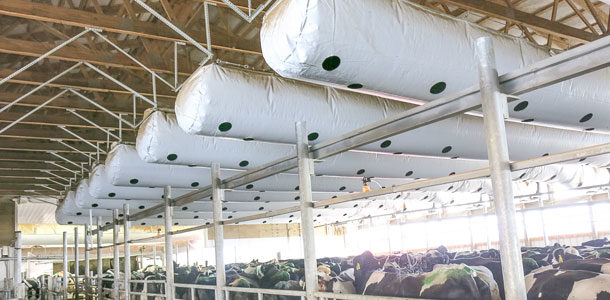Regardless of the season, dairy producers are always looking for ways to make their cows more comfortable, but when hot summertime temperatures set in, the holding area can be a particularly stale and sticky place.
Traditional fans have been used somewhat ineffectively in the past to provide cooling to this crowded location, but thanks to an innovative system developed by Dr. Ken Nordlund, emeritus professor at the University of Wisconsin – Madison, producers can now install a positive-pressure tube system that allows better and more complete ventilation throughout a holding area.
The tubes stretch across the length of the pens with sprinklers dispersed between them to allow cooling water to reach the cows, thus providing more consistent and evenly distributed cooling throughout the pen.
“The idea is to take fresh air from outside, carry it into the holding area and then deliver down to the backs of every cow at an optimal speed,” Nordlund says. “In contrast are the existing systems where we have recirculating fans delivering air at appropriate speeds but to a minority of the cows.”
He says the point of the system is to allow the delivery of air at a chosen speed to a desired area.
He also notes that there are two issues with the more traditional systems. Generally, there is not a good distribution of high-moving air; further, the air these systems distribute is often warm or humid air.
Traditional holding areas count on wind coming through the sidewalls, so if something is blocking this natural ventilation from coming in the sides of the holding areas, or if there is no breeze, the fans will basically just recirculate the existing poor-quality air throughout the area.
In contrast, the positive-pressure tube system moves air throughout the area at a speed of 300 to 400 feet per minute, delivering it to the level of the cows’ backs. Precisely placed holes in the tube produce the proper air velocity on every cow in that particular area.
Nordlund says moving the air with the level of accuracy accomplished through the positive-pressure tube system was not possible with other more traditional forms of ventilation.
The idea of putting these systems in the dairy holding areas came after using them to generate small amounts of fresh air in individual calf pens.
Nordlund says there have probably been more than 3,000 calf barns retrofitted with this positive-pressure tube system over the last five years, with popularity in the United States, Canada and Europe.
“We started thinking about holding areas where we want a draft on cows that are under heat stress,” he says. “We used the same systems and the same equations that we used to calculate the speed at various points and use it to deliver fresh, lower-humidity air at high speeds.”
Implementing this ventilation system in a holding area was not without its challenges. Nordlund said there were situations to work out in order to make the systems operate properly since the tubes had to be fairly close to the cows.
“We’re always in a battle with the crowd gate, which has to move below these tubes, and many of the crowd gates have been constructed with little regard for height, so many are too high,” he says. “If the crowd gate forces us to put the tubes up too high, we lose a lot of the efficiency of the system because we have to drive the air too far.”
Another issue to face is that any time a bend in a tube is required, efficiency is lost.
“We want the tube to be very straight without any curves or angles,” he says.
In terms of dairy size, Nordlund said the systems should work as well with smaller herds and holding areas as it would with larger dairies. But for those smaller operations where cows would normally spend less time in a holding area, it likely means the system would be more costly on a per-cow basis.
So far, the system has received positive reviews from producers, and the number of dairies implementing the system is growing. In doing so, those dairies should be seeing the added benefits of reduced electrical usage to cool the holding pens along with less noise in the milking area.
In his conversations with producers, Nordlund says often “boss” cows hog the cool air in traditional ventilation systems. This doesn’t happen with the positive-pressure tube system because the cooler air is so evenly spread throughout the holding area.
However, some of those “boss” cows have been known to make their way back to the holding pens after milking, presumably because of the more pleasant conditions created by this innovative cooling system.
Mitch Breunig of Mystic Valley Dairy in Sauk City, Wisconsin, installed the positive-pressure tube system in July of 2013, utilizing the system for the first full summer last year. He has been pleased with the results so far.
Breunig was using a traditional fan system in his holding area and said he was faced with either installing more fans for the 370 cows they milk or replacing them with this new system.
“I think this is more efficient, so for the fans you’re running, you’re getting more cool air,” he says. “It improves air quality. Heat stress is sort of cumulative, so if cows get hot they can handle it for one day, but for two or three days, it makes it worse. If you can keep them from getting too hot over time, it helps.”
Nordlund said the design of the tube systems should allow every cow in the holding area to be subjected to an equal cooling pattern, something that is better for all of the cows. And a happy cow is a more productive cow. PD
Tim Thornberry is a freelance writer based in Frankfort, Kentucky.
Photo courtesy of Dairyland Initiative.










